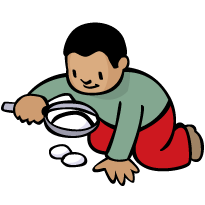Boston Children's Museum
308 Congress Street, Boston, MA 02210
617-426-6500
© Boston Children’s Museum 2025
Website Design by JackrabbitMosaics are traditionally created using small pieces of material like glass, stone, etc. to make colorful, often intricate patterns. In this activity, colored and white eggshells are used to produce a similar effect. Spring is a time of rebirth and renewal—and eggs! Many animals lay and incubate eggs in the spring, and in some cultures spring is a time in which kids paint, hide and eat lots of eggs. This makes it a great time to not only take a close look at eggs, but also to experiment with some of the things we can do with them. This activity is part of the Incredible Egg series of activities, which are designed to be done during the Spring—start your students off with some of the “egg science” activities, then move on to egg art, and finally take the Egg Drop Challenge!
See the instructions for The Incredible Egg for preparations regarding all of the activities in this series. For this activity, gather the materials needed. It might also be helpful for you to create your own mosaic first for children to see as an example. For the small mosaics that your students will be making, it is best to not create intricate images, but rather simple ones with large spaces filled with different colored shells.
Make sure to try out all of the other “Incredible Egg” activities:
Egg Science:
Egg Art:
Culminating Activity:

Ask your students if they have ever heard of a mosaic. How about tiles? Some students may have tiles in their bathroom at home. These are usually laid out in a straight up and down grid, but sometimes they have different colors or patterns. Mosaics are kind of like that, but much more colorful and creative. Mosaics are usually made by gluing small pieces of stone or glass in patterns or pictures. Tell your students that they will be making these pieces of art with colorful eggshells.
Create a beautiful piece of art with eggshells!
Was it difficult or easy to make the kind of mosaic they wanted to? Does anyone have any tips on how to create detailed or small areas, like thin lines of the colored eggshells? Any other ideas for how to make a good eggshell mosaic?
If you have the resources, you can encourage children to create another mosaic, building upon what they learned when they made their first one.